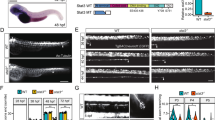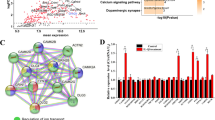Abstract
After peripheral nerve injury, Schwann cells are rapidly activated to participate in the regenerative process and modulate local immune reactions. Tumor necrosis factor-α (TNF-α), one of the major initiators of the inflammatory cascade, has been known to exert pleiotropic functions during peripheral nerve injury and regeneration. In this study, we aimed to investigate the in vitro effects of TNF-α on peripheral neural cells. First, gene-microarray analysis was applied to the RNA samples extracted from injured peripheral nerves, providing the information of gene interactions post nerve injury. Then, after primary cultured Schwann cells were treated with increasing dosages (0–40 ng/ml) of TNF-α, cell proliferation and migration were examined by EdU incorporation and a transwell-based assay, and cell apoptosis was observed and quantified by electron microscopy and Annexin V-FITC assay, respectively. The results showed that lower dosages of TNF-α increased cell proliferation and migration, whereas higher dosages of TNF-α decreased cell proliferation and migration and enhanced cell apoptosis. The tests using a chemical inhibitor of TNF-α further confirmed the above effects of TNF-α. To understand how TNF-α produced the dose-dependent dual effects on primary cultured Schwann cells, we performed co-immunoprecipitation, Western blot analysis, and immunocytochemistry to decipher the complex network of biochemical pathways involving many signaling molecules, i.e., TNF receptor-associated death domain, Fas-associated death domain, receptor interacting protein, JNK, NF-κB p65, and caspases, thus assuming the mechanisms by which TNF-α activated the death and survival pathways and achieved a balance between the two opposite actions in primary cultured Schwann cells.





Similar content being viewed by others
References
Joung YK, Bae JW, Park KD (2008) Controlled release of heparin-binding growth factors using heparin-containing particulate systems for tissue regeneration. Expert Opin Drug Del 5:1173–1184
Akassoglou K, Yu WM, Akpinar P, Strickland S (2002) Fibrin inhibits peripheral nerve remyelination by regulating Schwann cell differentiation. Neuron 33:861–875
Gumy LF, Bampton ETW, Tolkovsky AM (2008) Hyperglycaemia inhibits Schwann cell proliferation and migration and restricts regeneration of axons and Schwann cells from adult murine DRG. Mol Cell Neurosci 37:298–311
Chen YY, McDonald D, Cheng C, Magnowski B, Durand J, Zochodne DW (2005) Axon and Schwann cell partnership during nerve regrowth. J Neuropathol Exp Neurol 64:613–622
Lino MM, Atanasoski S, Kvajo M, Fayard B, Moreno E, Brenner HR, Suter U, Monard D (2007) Mice lacking protease nexin-1 show delayed structural and functional recovery after sciatic nerve crush. J Neurosci 27:3677–3685
Wagner R, Myers RR (1996) Schwann cells produce tumor necrosis factor alpha: expression in injured and non-injured nerves. Neuroscience 73:625–629
Mulleman D, Mammou S, Griffoul I, Watier H, Goupille P (2006) Pathophysiology of disk-related low back pain and sciatica. II. Evidence supporting treatment with TNF-α antagonists. Joint Bone Spine 73:270–277
Schäfers M, Geis C, Brors D, Yaksh TL, Sommer C (2002) Anterograde transport of tumor necrosis factor-α in the intact and injured rat sciatic nerve. J Neurosci 22:536–545
Pollheimer J, Knöfler M (2005) Signalling pathways regulating the invasive differentiation of human trophoblasts: a review. Placenta 26:S21–S30
Boyle K, Azari MF, Cheema SS, Petratos S (2005) TNF [alpha] mediates Schwann cell death by upregulating p75NTR expression without sustained activation of NF [kappa] B. Neurobiol Dis 20:412–427
Wang Y, Tang X, Yu B, Gu Y, Yuan Y, Yao D, Ding F, Gu X (2012) Gene network revealed involvements of Birc2, Birc3 and Tnfrsf1a in anti-apoptosis of injured peripheral nerves. PLoS ONE 7:e43436
Tao T, Ji Y, Cheng C, Yang H, Liu H, Sun L, Qin Y, Yang J, Wang H, Shen A (2009) Tumor necrosis factor-alpha inhibits Schwann cell proliferation by up-regulating Src-suppressed protein kinase C substrate expression. J Neurochem 111:647–655
Wright GW, Simon RM (2003) A random variance model for detection of differential gene expression in small microarray experiments. Bioinformatics 19:2448–2455
Brockes JP, Fields KL, Raff MC (1979) Studies on cultured rat Schwann cells. I. Establishment of purified populations from cultures of peripheral nerve. Brain Res 165:105–118
Mantuano E, Inoue G, Li X, Takahashi K, Gaultier A, Gonias SL, Campana WM (2008) The hemopexin domain of matrix metalloproteinase-9 activates cell signaling and promotes migration of Schwann cells by binding to low-density lipoprotein receptor-related protein. J Neurosci 28:11571–11582
Mirsky R, Jessen KR (2001) Embryonic and early postnatal development of Schwann cells. In: Jessen KR, Richardson WD (eds) Glial cell development: basic principles and clinical relevance. Oxford University Press, Oxford, pp 1–20
Harrisingh MC, Perez-Nadales E, Parkinson DB, Malcolm DS, Mudge AW, Lloyd AC (2004) The Ras/Raf/ERK signalling pathway drives Schwann cell dedifferentiation. EMBO J 23:3061–3071
Mirsky R, Parmantier E, McMahon AP, Jessen KR (1999) Schwann cell-derived desert Hedgehog signals nerve sheath formation. Ann N Y Acad Sci 883:196–202
Chen ZL, Strickland S (2003) Laminin γ1 is critical for Schwann cell differentiation, axon myelination, and regeneration in the peripheral nerve is critical for Schwann cell differentiation, axon myelination, and regeneration in the peripheral nerve. J Cell Biol 163:889–899
Yoshifumi T, Martin K (2011) Axonal outgrowth is associated with increased ERK 1/2 activation but decreased caspase 3 linked cell death in Schwann cells after immediate nerve repair in rats. BMC Neurosci 12:12. doi:10.1186/1471-2202-12-12
Joy AM, Beaudry CE, Tran NL, Ponce FA, Holz DR, Demuth T, Berens ME (2003) Migrating glioma cells activate the PI3-K pathway and display decreased susceptibility to apoptosis. J Cell Sci 116:4409–4417
Yuan Q, Yang H, Cheng C, Li C, Wu X, Huan W, Sun H, Zhou Z, Wang Y, Zhao Y, Lu X, Shen A (2012) Beta-1,4-galactosyltransferase I involved in Schwann cells proliferation and apoptosis induced by tumor necrosis factor-alpha via the activation of MAP kinases signal pathways. Mol Cell Biochem 365:149–158
Thornberry NA, Lazebnik Y (1998) Caspases: enemies within. Science 281:1312–1316
Profyris C, Cheema SS, Zang DW, Azari MF, Boyle K, Petratos S (2004) Degenerative and regenerative mechanisms governing spinal cord injury. Neurobiol Dis 15:415–436
Gupta S (2002) A decision between life and death during TNF-alpha-induced signaling. J Clin Immunol 22:185–194
Chen G, Goeddel DV (2002) TNF-R1 signaling: a beautiful pathway. Sci Signal 296:1634
Harris CA, Johnson EM Jr (2001) BH3-only Bcl-2 family members are coordinately regulated by the JNK pathway and require Bax to induce apoptosis in neurons. J Biol Chem 276:37754–37760
Gupta S (2002) Tumor necrosis factor-alpha-induced apoptosis in T cells from aged humans: a role of TNFR-I and downstream signaling molecules. Exp Gerontol 37:293–299
Waiwut P, Shin MS, Inujima A, Zhou Y, Koizumi K, Saiki I Sakurai H (2011) Gomisin N enhances TNF-α-induced apoptosis via inhibition of the NF-κB and EGFR survival pathways. Mol Cell Biochem 350:169–175
Kim GM, Xu J, Song SK, Yan P, Ku G, Xu XM, Hsu CY (2001) Tumor necrosis factor receptor deletion reduces nuclear factor-kappaB activation, cellular inhibitor of apoptosis protein 2 expression, and functional recovery after traumatic spinal cord injury. J Neurosci 21:6617–6625
Yin X, Krikorian P, Logan T, Csizmadia V (2010) Induction of RIP-2 kinase by proinflammatory cytokines is mediated via NF-kB signaling pathways and involves a novel feed-forward regulatory mechanism. Mol Cell Biochem 333:251–259
Acknowledgments
We thank Professor Jie Liu for assistance in manuscript preparation. This study was supported by National Natural Science Foundation of China (Grant Nos. 81130080, 81000678, and 81171457) and the Priority Academic Program Development of Jiangsu Higher Education Institutions (PAPD).
Author information
Authors and Affiliations
Corresponding author
Rights and permissions
About this article
Cite this article
Tang, X., Wang, Y., Zhou, S. et al. Signaling pathways regulating dose-dependent dual effects of TNF-α on primary cultured Schwann cells. Mol Cell Biochem 378, 237–246 (2013). https://doi.org/10.1007/s11010-013-1614-x
Received:
Accepted:
Published:
Issue Date:
DOI: https://doi.org/10.1007/s11010-013-1614-x




